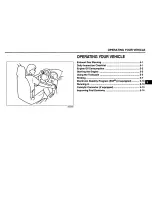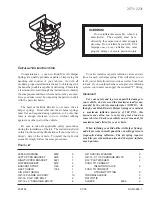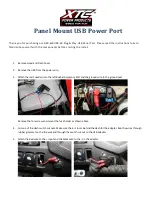
R
fail from being overheated
R
adversely affect handling
Overinflated tires
G
WARNING
Follow recommended tire inflation pressures.
Do not overinflate tires. Overinflated tires can
adversely affect handling and ride comfort,
wear unevenly, increase stopping distance,
and result in sudden deflation (blowout)
because they are more likely to become
punctured or damaged by road debris,
potholes etc.
Overinflated tires can:
R
adversely affect handling
R
wear excessively and/or unevenly
R
be more likely to become damaged
R
adversely affect ride comfort
R
increase stopping distance
Maximum tire pressure
G
WARNING
Never exceed the maximum tire inflation
pressure. Follow recommended tire inflation
pressures.
Do not underinflate tires. Underinflated tires
wear excessively and/or unevenly, adversely
affect handling and fuel economy, and are
more likely to fail from being overheated.
Do not overinflate tires. Overinflated tires can
adversely affect handling and ride comfort,
wear unevenly, increase stopping distance,
and result in sudden deflation (blowout)
because they are more likely to become
punctured or damaged by road debris,
potholes etc.
:
Maximum permitted tire pressure
(example)
i
The actual values for tires are specific to
each vehicle and may deviate from the
values in the illustration.
When adjusting the tire pressures always
observe the recommended tire pressure for
your vehicle (
Y
page 273).
Checking the tire pressures
Important safety notes
G
WARNING
Follow recommended tire inflation pressures.
Do not underinflate tires. Underinflated tires
wear excessively and/or unevenly, adversely
affect handling and fuel economy, and are
more likely to fail from being overheated.
Do not overinflate tires. Overinflated tires can
adversely affect handling and ride comfort,
wear unevenly, increase stopping distance,
and result in sudden deflation (blowout)
because they are more likely to become
punctured or damaged by road debris,
potholes etc.
Do not overload the tires by exceeding the
specified load limit as indicated on the Tire
and Loading Information placard on the
driver's door B-pillar. Overloading the tires
can overheat them, possibly causing a
blowout. Overloading the tires can also result
in handling or steering problems, or brake
failure.
276
Tire pressure
Wheels and tires
Содержание 2015 GLK
Страница 1: ...GLK Operator s Manual I n f o r ma t i o nP r o v i d e db y...
Страница 4: ...I n f o r ma t i o nP r o v i d e db y...
Страница 28: ...26 I n f o r ma t i o nP r o v i d e db y...
Страница 38: ...36 I n f o r ma t i o nP r o v i d e db y...
Страница 130: ...128 I n f o r ma t i o nP r o v i d e db y...
Страница 252: ...250 I n f o r ma t i o nP r o v i d e db y...
Страница 300: ...298 I n f o r ma t i o nP r o v i d e db y...
Страница 312: ...310 I n f o r ma t i o nP r o v i d e db y...
Страница 313: ...311 I n f o r ma t i o nP r o v i d e db y...
Страница 314: ...312 I n f o r ma t i o nP r o v i d e db y...
Страница 316: ...Order no 6515 0751 13 Part no 204 584 36 82 Edition A 2012 2045843682 2045843682 I n f o r ma t i o nP r o v i d e db y...
















































